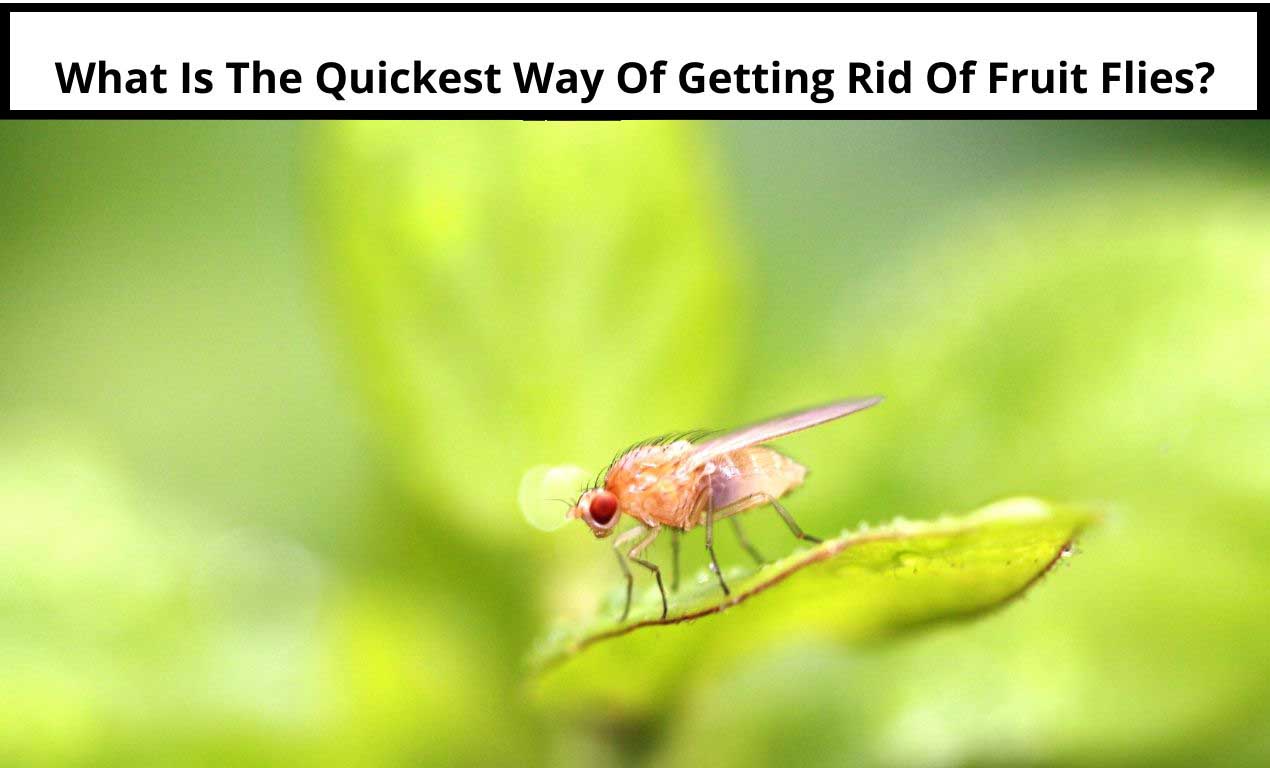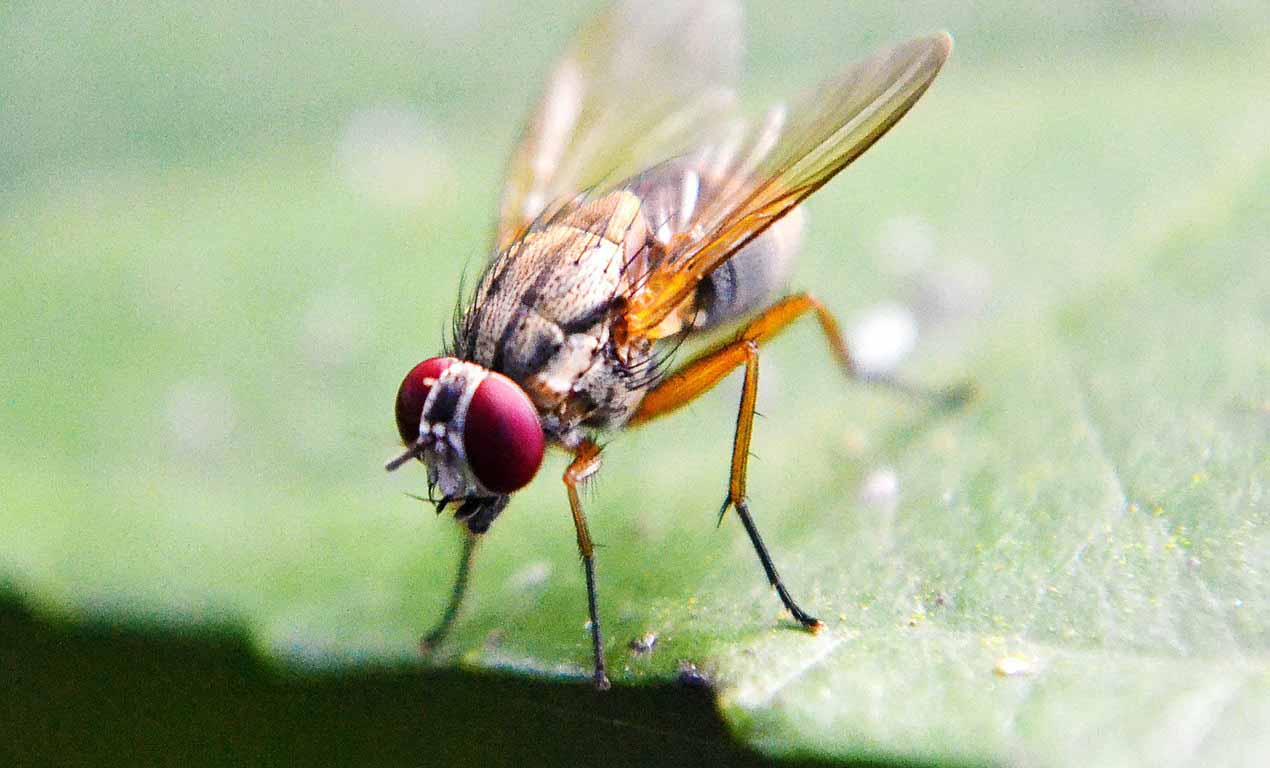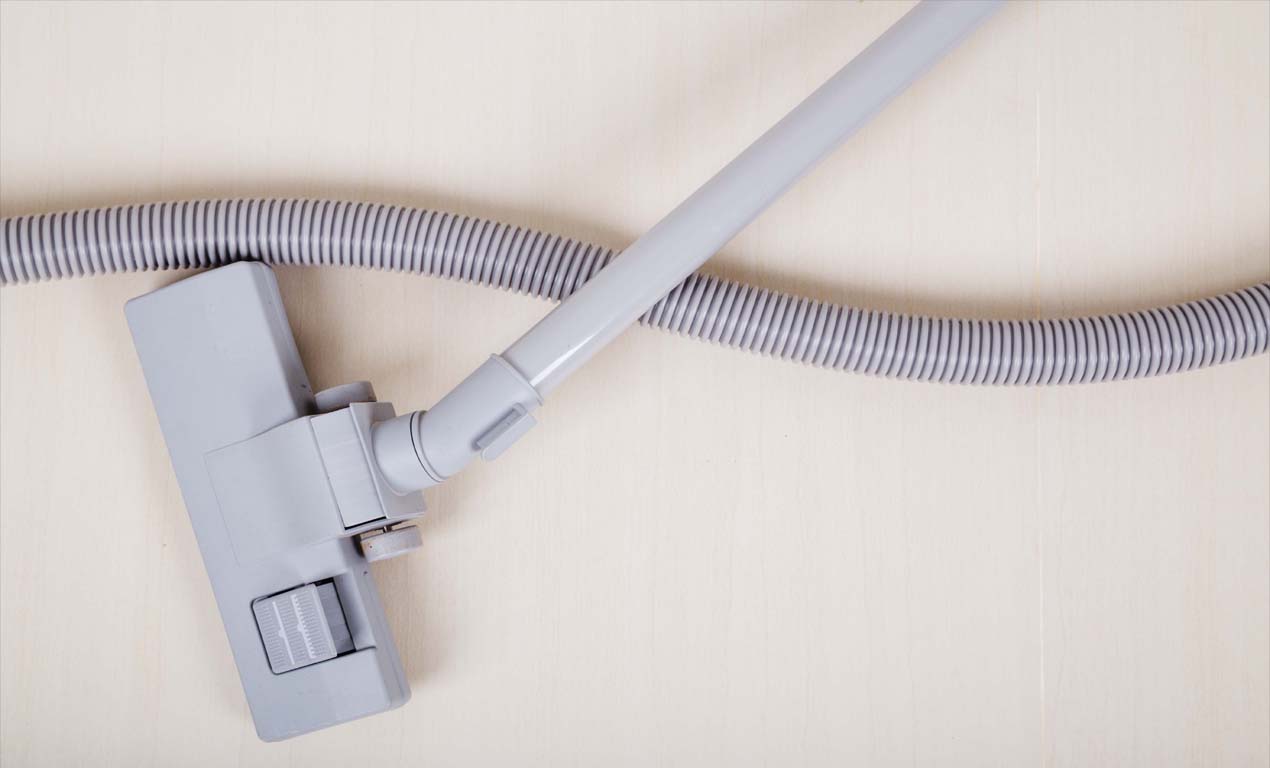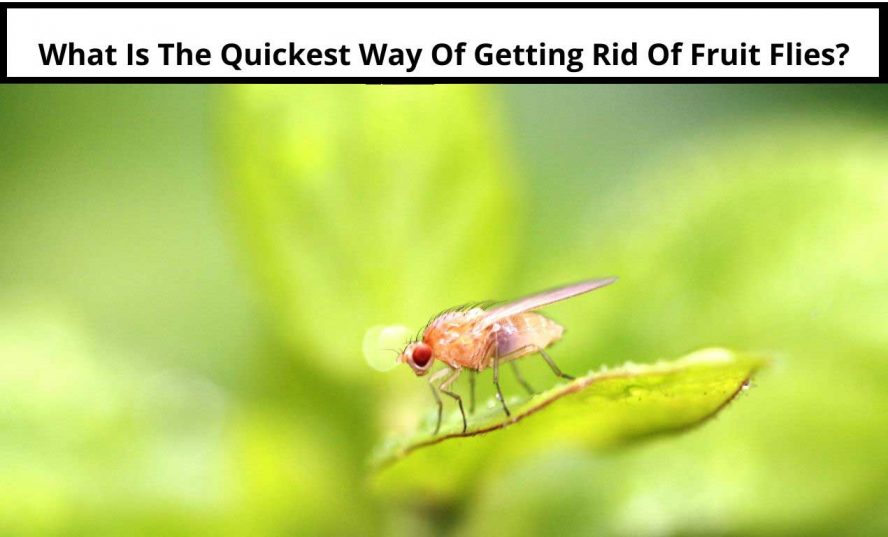 There are 3,000 species of fruit-flies in the world today. They are small, yellowish, red-eyed flies, which we find buzzing around fruits and rotting vegetables. Drosophila Melanogaster species are the common fruit-flies or Vinegar flies. Fruit flies can be very destructive and can cause serious harm to fruits and vegetables. They attack in high numbers and are difficult to remove. It better to know the quickest way to get rid of them, and you need to act fast to protect your fruits and vegetables.
There are 3,000 species of fruit-flies in the world today. They are small, yellowish, red-eyed flies, which we find buzzing around fruits and rotting vegetables. Drosophila Melanogaster species are the common fruit-flies or Vinegar flies. Fruit flies can be very destructive and can cause serious harm to fruits and vegetables. They attack in high numbers and are difficult to remove. It better to know the quickest way to get rid of them, and you need to act fast to protect your fruits and vegetables.
So, what is the quickest way of getting rid of fruit flies? Vacuum cleaner and swatter is the fastest way to get rid of fruit flies. Vacuum cleaner will instantly vacuum them and once they are in they will die. Swatter will kill them instantly. You just need to hit them properly. It is a little hard and works perfectly.
There are other ways that are also highly effective. Please continue reading to know them in details
Brief Description
Fruit-fly sizes vary between one-tenth to one-fourth of an inch in length. Males are shorter than females. We find them in the following color combination – yellow, brown, and black. Males have a dark patch on their abdomen. Both flies have dark rings around their abdomen.
Habitat
Fruit flies get particularly attracted to rotting and fermenting fruits and vegetables. Also, they also like garbage, drains, and wet mops to breed. They need a moist and warm climate to thrive. In addition to fruit orchards and garden, these flies get found in home and restaurant, where there is the presence of fresh and rotten fruits.
Some common locations they get found are bags containing onions and potatoes; overripe fruits like banana, pineapple, and tomatoes; vinegar, beer or wine containers and lids; all rotting organic matter; leaking drainage or under the sink.
Reproduction
Fruit-flies have a short life span. The female flies lay eggs near the source of organic and decaying matter, where their larvae can find enough food source to grow and pupate. Males prefer long courtship and mating periods compared to females. Once the female gets impregnated with the sperm, they use them to fertilize her eggs and lays them in small quantities. They lay around 400 eggs in her lifetime.
Under suitable conditions, these eggs hatch into larvae within a day. The larvae, for the next four days, feeds from the surrounding, molts twice, and crawls to a dry place to enter into the pupa stage. In the puparium, the metamorphosis of the larvae to adult fruit-fly occurs for the next four days, and finally, the adult fly emerges.
Female fruit-fly becomes sexually active after around ten hours of being born. Their requirement of male sperm to fertilize all her eggs gets accomplished with only one mating. While, the male continues to mate with various females, distributing his sperm for the future breed of their species.
Why Do We Wish To Get Rid Of Fruit Flies?
 Fruit-flies are not a pest like the common housefly. They do not carry any pathogen for humans to fall ill. The only areas of concern with these pests are their infestation, spoiling of fresh fruits and vegetables, and ending up inside our fruit containers and fermented drinks. They can discolor the banana skin or make your over-ripe grapes rotten.
Fruit-flies are not a pest like the common housefly. They do not carry any pathogen for humans to fall ill. The only areas of concern with these pests are their infestation, spoiling of fresh fruits and vegetables, and ending up inside our fruit containers and fermented drinks. They can discolor the banana skin or make your over-ripe grapes rotten.
Where Do They Come From?
There are multiple ways, fruit-flies find their way into your home. They may come via the fruit basket from your grocers. The aroma of ripe fruits and fermented drinks attract fruit-flies from outside. If your house is dirty with left-over food or overflowing garbage bin, it’s sure to attract these pesky insects.
Will The Fruit-Flies Go Away?
Fruit-flies have a short life span of up to a month. However, if the surrounding is conducive for the females to lay their eggs, then these will hatch into hundreds of fresh flies.
Which Is The Best Way To Get Rid Of Fruit Flies?
There are innumerable ways to get rid of these flies. Let’s look at the following:
Clean surrounding
Make your living space hygienic. Clean your house regularly, especially around places you eat and store your food. Do not leave left-over food, bottles in a corner. Remove trash daily from inside and dispose of them into garbage bins outside. Ensure that the garbage bin is not overflowing. Keep them tightly closed and get them cleared periodically.
Check for any fruits and vegetables that may have rolled under the sink or behind the freezer. Do not keep your fruits and vegetables exposed on your kitchen counters. Cover them in such a fashion that the fruit-flies cannot access them, and alongside they get well ventilated. Follow the first-in, first-out process, so that over-ripe and rotten fruits settle at the bottom of the fruit-baskets for the flies to get attracted.
Refrigerate all ripened fruits, and do not leave them in the open. Wash your fruits and vegetables before storage. Most of the infestation comes from outside. Flies require just one rotten fruit to lay her eggs!
Do not store empty beer cans and wine bottles in the basement. Dispose of them at the earliest. Even remnant liquid would send strong odor for these flies to get attracted. Mop all spilled liquids with soap and water, clean and dry the mop, before storage.
If the infestation persists even after eliminating adult fruit-flies, you have to identify their nearby breeding grounds. As stated, adult life is limited, and if breeding does not get stopped, their menace will continue. Check for such a location immediately outside your home.
This could be clogged drainage, leaking pipes, compost lying near your porch or unkempt garden, and flower pots. Female flies are always on the lookout to lay their eggs! Management of fruit-fly is more crucial than just eradicating these flies.
Some DIY Ideas To Eliminate Fruit-Flies:
Homemade Fruit-Fly Traps
We know that fruit-flies get attracted to fermented juices like the beer and wine. Similarly, they like the smell of lemon, banana, tomatoes, pineapple, and berries. These could get used as baits in your trap.
Vinegar Trap
This is the most common traps for fruit-flies. Take a few glasses, jars, or bottles. Half fill them with apple cider vinegar or old beer. Add a few drops of dishwasher liquid and stir well without creating a foam. Close the mouth of the container with plastic or cellophane, and fix it with rubber-band. Make some small holes on the surface for the fruit-flies to get in. If you do not wish to use plastic, use paper cones.
The fruit-flies will get attracted by the strong aroma of the apple cider and get into the container. The soap will limit the surface tension of the vinegar so that the flies will not be able to sit on top. They would all soon drown in the liquid. Once you have large quantities of these dead flies, flush them out. Use a sufficient number of such traps, depending upon the density of these flies.
Other Traps
Similar traps can get made with beer, overripe plantain, and berries. Either you can add some soap in the liquid trap or microwave the container to eliminate the trapped fruit-flies.
Boiling Vinegar Or Water
Fruit-flies breed along the ledges inside your kitchen sink. Pour boiling white vinegar or water in large quantities down your drain to flush out the eggs and larvae infestation at these places.
Yeast Trap
This is another effective fruit-fly trap that works. Fill half a glass with warm water, add one teaspoon of sugar and some dry yeast. Mix the ingredients well and allow the bubbles to settle down. Cover the glass with cellophane and fix around the edge with rubber-band. Make a few small holes on the cellophane for the fruit-flies to enter. Keep this trap near your fly-infested area.
Fly-Strips
 Fly-strips can get hung in the corner, where you have noticed a large number of fruit-flies congregating. You can trap a large number of flies through this method.
Fly-strips can get hung in the corner, where you have noticed a large number of fruit-flies congregating. You can trap a large number of flies through this method.
Basil
Fruit-flies detest basil. Hence, you can grow fresh basil in small pots and keep them indoors near your kitchen counter or where you store your fruits and vegetables. Fruit-flies will soon leave this vicinity.
Cedarwood
This is another natural repellant that is disliked by fruit-flies. Keep a bunch of cedarwood as decoration near the fruit-fly infestation. You could also burn them in your fireplace. Fruit-flies will soon vanish from these areas.
Essential Oils
Mix a few drops of lemongrass or lavender oil with water, fill it into your sprayer, and apply generously. Very soon, you will find the fruit-flies leaving their abode. They are highly repulsive to these odors, and alongside, you will freshen up your home.
Killing Them Quickly
 Here are a few ways, which gets used to kill them instantly:
Here are a few ways, which gets used to kill them instantly:
Swatter: Get hold of a light-weight unbreakable melamine plate and coat one surface with cooking oil. Swat the area infested with these small flies. Most of them will get stuck to your plate surface and very quickly perish.
Hairdryer: Switch on your hairdryer and turn the blower towards these flies, where the air gets sucked in. These flies would get caught in the suction and die from the heat generated by the dryer.
Incense sticks: These small fruit-flies need fresh air to breathe. If you burn incense sticks near their breeding ground or where they congregate, the smoke and the smell will slowly suffocate and kill them.
Vacuum cleaner: Empty the bag inside the vacuum cleaner. Set a plate with some rotten berries and banana for all the fruit-flies to settle down to their feast. Use the pipe with a wide opening and set the vacuum to high. Switch on the cleaner and aim it directly at the flies. All of them will quickly get sucked inside your vacuum. Incinerate your bag full of these horrendous creatures.
Off The Shelf Products
There are many off-the-shelf products available like “Aunt Fannie’s FlyPunch!” Buy them, read the instruction, and use them appropriately to annihilate these flies.
Conclusions
Fruit-flies are pesky but not a pest. They do not harm humans except for creating an unhealthy atmosphere and damaging your food. There are innumerable ways they can get removed. However, the most critical factor for their eradication is the management of their infestation. Identify and remove their eggs and larvae from breeding. Keep your surroundings clean to avoid their infestation in the future!
Welcome to my blog. I have been doing pest control for years since my house, garden and pets were always attacked by various kinds of pests and as a result I had to know proper pest control techniques that works. In this blog I share all the tips and tricks that I know and I hope you’ll find it helpful.

